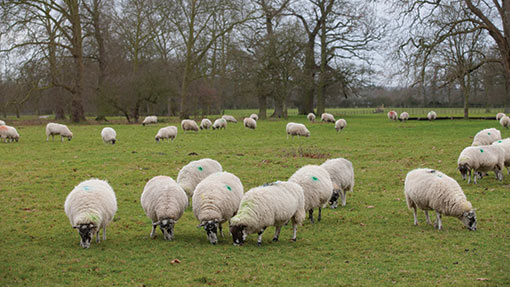How to identify and manage maedi visna and Johne’s in ewes

When weight loss in ewes is unexplained, one of two diseases – both of which are difficult to diagnose – could be to blame.
“Two possible causes that could explain thin ewes are Johne’s and maedi visna,” says Eblex beef and sheep scientist Liz Genever.
But while identifying maedi visna (MV) and Johne’s is problematic, ewes losing weight for no apparent reason is a reliable indicator.
See also: Maedi visna infections in sheep on the increase
“It is definitely worth talking to your vet about investigating thin ewes, especially once they have been given an opportunity to gain weight,” Dr Genever advises farmers.
The number of flocks infected with the MV virus has doubled to 2.8% in the past 15 years, while in flocks with Johne’s, up to 10% of ewes can die.
Maedi visna
MV can be spread through purchasing infected stock; half the flock could be infected before animals display visual signs such as loss of body condition, poorer fertility, mastitis, increased twin lamb disease and smaller, weaker lambs. Poorer quality and quantity of colostrum and milk is a factor too.
“By the time signs of infection are seen, usually years after the virus has been introduced, the infection has reached such a high level that it is very difficult to control,” Dr Genever explains.
There is no cure for MV – neither is there a vaccine to prevent or control it – but good biosecurity and a blood test diagnosis before breeding stock is bought in will help protect a flock from infection.
Johne’s
Purchasing infected stock is also the main route for introducing Johne’s – caused by bacteria on grass – to a farm. But because the incubation period is between two and four years, animals often don’t display signs until later in life. By this time, ewes may have passed the disease to their unborn lambs.
What will be apparent, though, is a high culling rate due to poor body condition. “If ewes around three to four years old with normal teeth and on good diets demonstrate poor condition, weight loss and poor fleece condition, Johne’s is a potential cause,” Dr Genever said.
Poor control of parasites such as liver fluke can worsen the severity of Johne’s.
There is no single diagnostic test – subclinically infected stock can even test negative – but the disease can be picked up in blood or muck samples and, more reliably, through post-mortem examinations.
Dr Genever advised early culling of affected animals and their offspring. Effective vaccination is available from a vet.
By the time signs of infection are seen, an infection can be at such a high level that it is very difficult to control.
‘Blood tests are vital tool’
Michael Skinner lost half his flock when blood tests confirmed maedi visna as the underlying cause of health issues.
The diagnosis didn’t come until seven years after the flock’s health first began to deteriorate. “The sheep weren’t thriving, there were unexplained abortions, lameness and high rates of mastitis,” recalls Mr Skinner, who farms near Market Harborough, Leicestershire.
When maedi visna was eventually diagnosed, it had infected half his North Country Mule flock. “By then we were down from 1,200 to 800 because of the health problems we had already experienced. We culled another 400 after the blood tests because we didn’t want to infect other sheep. That was a significant financial hit.”
The flock was again tested three months later and a further 45 culled. “The blood test doesn’t identify the carriers; they can be carrying the virus for three months before symptoms appear,” Mr Skinner explains.
What surprised him was how healthy some of the infected sheep looked. “You can have it for a long time before you reach a point where it becomes a significant factor,” he says.
Four hundred replacements were purchased from a trusted source. Mr Skinner opted to change the breed to a Highlander, to allow a transition to a more extensive system. He believes lambing outside will reduce the chances of reinfection.
Mr Skinner is now running the Mules and the Highlanders as two separate flocks. He aims to rebuild numbers to 1,200 within two years, but won’t be buying in more sheep. “We used to buy from markets and big sales, but the risk is too high.”
He has focused on biosecurity improvements, too, keeping the flocks 2m away from other sheep and making sure gates and fences are secure. Lambs are now easier to finish.
He’s not certain that he has eradicated MV from the flock entirely – he will retest after the last of the Mules have gone.
He urges farmers to blood test their own flocks. “By blood sampling just a few they can establish if there is a problem.”
